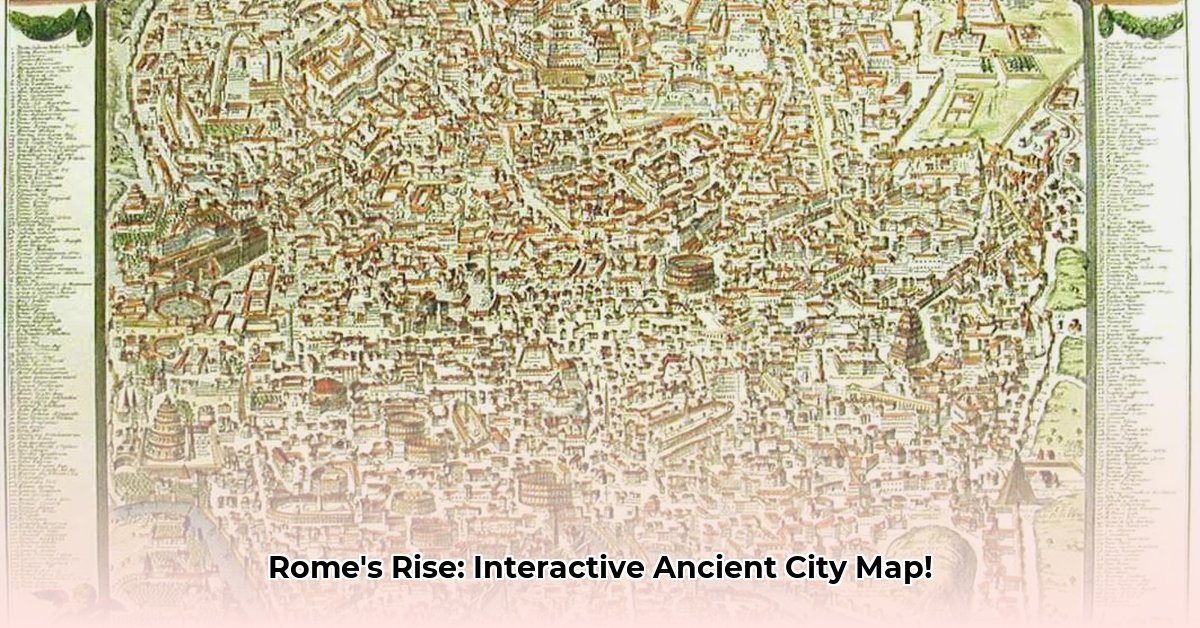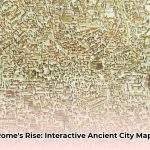Imagine traversing the bustling streets of ancient Rome, not through the faded descriptions of old texts, but with the immersive power of modern technology. Envision peeling back the solemn layers of centuries to witness Rome as it once was: a city teeming with vibrant life, where the whispers of senators and the clamor of markets echoed through burgeoning streets. This profound experience is now a tangible reality. Forget the dusty, static textbooks of old; we are stepping into a captivating realm of interactive digital maps that allow us to explore the Eternal City with unprecedented intimacy and detail. See an example of an ancient Rome map .
These digital cartographic marvels are fundamentally revolutionizing our engagement with history. They offer dynamic pathways to explore the urban planning genius, intricate civic structures, and the very pulse of daily Roman life, meticulously tracing this incredible metropolis’s historical development and the grand sweep of the Roman Empire. This article delves into why these sophisticated digital maps are a true game-changer for anyone captivated by ancient civilizations. We will journey through various map options, from meticulously reproduced historical cartography to groundbreaking interactive digital humanities projects, and uncover their profound usefulness for everyone from dedicated history teachers to inquisitive armchair travelers. Furthermore, we will peer behind the digital curtain to see how leading experts are meticulously constructing these virtual Romes, ensuring their historical accuracy and laying the groundwork for future archaeological discoveries and historical reconstruction.
City of Rome Ancient Map: Peeling Back the Layers of Time
Step into the very heart of the ancient world. Picture yourself amidst the vibrant Roman Forum, where the air, thick with the scent of commerce and the murmur of political debate, once crackled with history’s raw energy. Thanks to the marvel of digital mapping, this evocative dream is now a tangible reality. These digital tools are profoundly transforming how we perceive and interact with the past, offering a mesmerizing, almost tactile, glimpse into the heart of a civilization that etched its indelible mark upon our modern world. So, how can we best navigate this rich digital landscape and unlock the profound secrets held within these ancient maps of the Eternal City?
Rome: A Metropolis Forged in History
The story of Rome, a saga spun over millennia, commences around 753 BC according to enduring legend, attributed to Romulus and Remus. From its humble origins as a cluster of settlements on modest hills, Rome swelled into the undisputed epicenter of a colossal empire. Its formidable influence stretched across continents, shaping the very course of Western civilization. The urban landscape endured countless transformations, each leaving an indelible mark on the city’s unique character. One might consider it akin to a mighty, ancient oak; its roots deeply embedded in the rich soil of history, its branches extending far and wide, bearing the rich fruits of innovation, relentless conquest, and unparalleled cultural exchange.
Enduring monuments, such as the awe-inspiring Colosseum, the once-vibrant Roman Forum, and the majestic Pantheon, stand as monumental testaments to Rome’s glorious past. They whisper compelling tales of emperors, courageous gladiators, and the daily lives of its countless citizens. These structures serve as tangible proof of Rome’s enduring presence, reminding us of its profound and pervasive impact on art, architecture, law, and global politics. Do these echoes of antiquity not stir a deeper curiosity within us, urging us to explore their origins and development?
Digital Maps: Your Personal Time-Traveling Device
Digital maps are far from static images; they are, in essence, magical portals painstakingly crafted to transport you directly into the vibrant heart of ancient Rome. These advanced tools offer dynamic pathways to explore the city’s intricate civic structures, revealing the day-to-day lives of the myriad people who inhabited it, and meticulously tracing the historical development of this incredible metropolis. One can literally imagine peeling back the layers of time, observing the Roman Forum as it buzzed with fervent activity, or exploring the residential neighborhoods where ordinary Romans lived, worked, and played out their destinies. It is truly like having a personal time machine at your fingertips, allowing you to witness the rise and fall of this titanic empire from the comfort and convenience of your own home! These interactive maps redefine historical engagement.
Exploring Key Roman Landmarks with Digital Precision
Digital maps illuminate the evolution of Rome’s most iconic structures, offering detailed glimpses into their construction, function, and transformation over centuries.
- The Colosseum (Amphitheatrum Flavium): Digital maps bring to life the immense scale of this amphitheater, built during the Flavian dynasty. They can show its original location relative to Nero’s colossal statue, which gave the structure its later, enduring name. Such maps allow users to explore the intricate underground passages (hypogeum) and seating arrangements, understanding its role in gladiatorial contests and public spectacles.
- The Roman Forum: As the political, religious, and commercial heart of ancient Rome, the Forum’s complexity is best understood through interactive maps. Users can toggle layers to see its evolution from a marshy valley to a monumental urban space. Identify the Temple of Castor and Pollux (T. Castor), the Temple of Vesta (Vestae), and the Curia (Comitium). Digital reconstructions vividly portray the bustling activity of this civic center, demonstrating its central importance to Roman life.
- The Pantheon: Examine the architectural brilliance of this temple, later a church. Digital maps illustrate its unique oculus and dome structure, enabling exploration of its historical context through its three major iterations. The famous inscription “M·AGRIPPA·L·F·COS·TERTIVM·FECIT” is often linked within the digital interface to explain its origins under Agrippa and subsequent reconstructions under Hadrian.
- Roman Walls: Trace the city’s defensive perimeters, from the early Servian Wall (Latin: Murus Servii Tullii) to the later, more extensive Aurelian Walls (Latin: Muri Aureliani). Digital maps clearly depict their routes, showing how the city expanded beyond its original boundaries. Understanding the strategic necessity of the Aurelian Walls in the 3rd century AD—a time of barbarian incursions and civil unrest—is enhanced by seeing their integration with existing structures like the Castra Praetoria, the barracks of the Praetorian Guard.
- The Tiber River and its Bridges: The Tiber was Rome’s lifeline. Digital maps highlight its meandering path and the critical bridges connecting parts of the city. Explore the Pons Fabricius, Rome’s oldest bridge (62 BC), and the Pons Aelius (known today as Ponte Sant’Angelo), leading to Hadrian’s Mausoleum. These maps allow us to grasp the river’s role in trade, transport, and defense, revealing locations like Tiber Island (Insula), a site of ancient temples and continuous habitation.
- Hills and Urban Expansion: Rome was famously built on seven hills. Digital maps clearly delineate these, including the Palatine Hill (Palatium), the Capitoline Hill (Capitolium), and the Aventine Hill (Aventius Mons). Observe how the city expanded, annexing areas like the Campus Martius (Field of Mars), initially a military training ground, which gradually filled with theaters, baths, and public buildings.
- Baths and Entertainment Venues: Visualize the immense scale of Roman public baths like the Thermae Diocletianae (Baths of Diocletian) and the Thermae Neronianae (Baths of Nero and Alexander). Digital maps showcase their layouts, revealing their function as social and recreational hubs. Explore the Circus Maximus, famed for chariot races, and the Theater of Pompey (Theatrum Pompeii), site of Julius Caesar’s assassination. These maps bring to life the sophisticated nature of Roman leisure and public life.
- Roads and Aqueducts: Key to the Roman Empire’s control and growth were its vast road networks and ingenious aqueducts. Digital maps illustrate the Via Appia (Appian Way), Rome’s first “highway,” and various aqueducts (e.g., Aqua Traiana), demonstrating their critical role in connecting the empire and supplying the city with fresh water.
Who Benefits from These Digital Wonders?
These sophisticated maps aren’t merely useful for a handful of history experts or archaeological evidence interpreters. Their utility is remarkably broad, extending to a wide array of individuals and institutions including educators, diligent students, meticulous researchers, curious tourists, and dedicated cultural heritage managers. The transformative possibilities are truly limitless!
| Group | Immediate Benefits (Within a Year) | Future Possibilities (3-5 Years) |
|---|---|---|
| Educators and Learners | Facilitate virtual tours for immersive learning experiences, support research projects on Roman life, enable detailed exploration of ancient homes and marketplaces. | Develop interactive courses using digital data, foster collaborative mapping projects to engage students deeply, create personalized learning experiences tailored to individual interests. |
| Historians and Scholars | Enable contributing new data to dynamic digital maps, assist in identifying crucial gaps in our knowledge of Rome, and facilitate advanced spatial analysis of ancient structures. | Lead to the reconstruction of ancient Rome in intricate 3D models, open new research questions utilizing advanced digital urban mapping project, and aid in uncovering hidden patterns and relationships within the urban landscape. |
| Cultural Site Professionals | Design engaging museum exhibits, enhance archaeological site tours with interactive elements, provide immersive virtual reality experiences for visitors. | Support robust long-term preservation planning, facilitate advanced Roman heritage site management, and develop augmented reality apps that bring the ancient city to life for contemporary tourists. |
| Tourists and History Buffs | Aid in planning trips and understanding key sites, enable learning about the profound significance of Roman landmarks, and assist in creating personalized itineraries based on individual interests. | Offer incredibly immersive virtual tours of ancient Rome, provide interactive maps for in-depth exploration, and grant access to hidden gems and lesser-known historical sites. |
Hurdles and Opportunities in Digital Mapping
Crafting a truly trustworthy and comprehensive ancient Rome map in a digital format is far from simple! Representing complex historical information digitally, in a way that is both precisely accurate and intuitively easy to understand, presents a unique set of challenges. The crucial task is to strike a delicate balance between rigorous historical accuracy and exceptional user-friendliness. It is somewhat akin to transforming a verbose, intricate research paper into an excitingly engaging film. One would certainly desire to remain utterly true to the established facts, but concurrently, one also wishes to keep the audience profoundly engaged and thoroughly entertained. This balance is key to impactful digital archives.
Step-by-Step: How to Explore Ancient Rome Digitally
Eager to embark on your very own digital journey through ancient Rome? Follow these practical steps to begin your adventure:
- Discover Reputable Online Digital Map Resources: Begin by exploring reputable online digital map resources. Seek out platforms provided by esteemed academic institutions or established archaeological organizations. These resources frequently offer meticulously detailed and highly accurate reconstructions of ancient Rome, often leveraging advanced Geographic Information Systems (GIS) for precision. Examples include projects from universities, digital humanities initiatives, and dedicated historical mapping websites.
- Focus on Specific Areas of Interest: Are you particularly fascinated by the intricate design of Roman houses? Are you more intrigued by the bustling trade conducted within the Forum? Or perhaps the engineering marvels of aqueducts captivate you? By narrowing your focus, you can uncover a wealth of specific and fascinating information, allowing for deeper dives into particular aspects of Roman life and historical reconstruction. Utilize search functions or thematic layers within the digital map to hone your exploration.
- Utilize Virtual Tours and 3D Reconstructions: To truly deepen your understanding and engagement, make full use of available virtual tours and intricate 3D reconstructions. These highly interactive components are designed to truly bring ancient Rome to vivid life, allowing for an immersive experience that goes beyond static images. Many platforms offer fly-throughs, guided pathways, and even the ability to “walk” through ancient spaces.
What’s Next for Mapping Rome?
The future of mapping Rome is brimming with exciting and innovative possibilities. Imagine readily available augmented reality (AR) applications that allow you to seamlessly view the ancient city’s structures and bustling life overlaid onto modern-day Rome, transforming mundane streets into vibrant historical scenes. Collaborative urban mapping project initiatives and cutting-edge virtual reconstructions will almost certainly generate even more engaging and profound experiences, enriching our understanding of this cultural heritage. These pioneering technologies offer a future where the past is not merely recalled but is made more accessible and experientially rich than ever before. We can anticipate more sophisticated AI-driven reconstruction, leveraging big data from countless archaeological discoveries to create ever more accurate and detailed digital models of the ancient city.
How To Use Rome Maps: A Cartographer’s Guide
Decoding Rome’s Cartographic History
Imagine holding a roadmap that depicts not just streets, but the very aspirations of an entire empire. That is essentially what ancient Roman maps represented. They were far more than mere geographical representations; they were profound statements of Roman dominance, ingenuity, and urban planning. So, how to use Rome maps to unlock the secrets they so diligently hold? We must first grasp their inherent blend of practicality and powerful propaganda. Early maps often prioritized function over pinpoint accuracy. Consider, for instance, the Tabula Peutingeriana, a sprawling, highly stylized depiction of the Roman road network. Distances might have been exaggerated, and certain details skewed, yet it served its multifaceted purpose: diligently guiding travelers, astute merchants, and formidable soldiers across the vast expanse of the empire. This dedication to ancient civil engineering was part of Rome’s enduring legacy.
The Eternal City in Pixels: Digital Reconstructions
Now, let us fast forward to the astonishing digital age. We are no longer confined to deciphering fragmented parchments and faded ink. Today, interactive digital maps offer unprecedented avenues to explore ancient Rome. These are not simply aesthetically pleasing pictures; they are meticulously researched reconstructions meticulously built upon a bedrock of archaeological evidence and exhaustive parsing of historical texts.
For diligent historians and researchers, this means an unparalleled ability to analyze intricate urban planning, complex infrastructure, and even the nuances of daily life with incredible precision. Can you imagine the power of overlaying different periods of Roman history onto a single map, meticulously tracing the city’s organic growth and profound evolution? How precisely did the Forum transform over the span of centuries? Where were the most significant temples and public buildings strategically located? These powerful digital tools provide not just answers but also profound insights into the historical geography of the Roman world, allowing for new hypotheses to be tested and old assumptions to be challenged.
Equally, dedicated educators can breathe vibrant new life into their history lessons by seamlessly incorporating these maps into their curricula. Instead of students merely reading about the grandeur of the Colosseum, they can virtually walk through it, experiencing its monumental scale and historical significance firsthand. Similarly, insightful tour guides can leverage these maps to significantly enhance their tours, offering visitors a far deeper and more nuanced understanding of the city’s rich and complex past, perhaps even allowing them to compare the ancient layout with the modern urban fabric.
Actionable Insights: Who Benefits Most?
Let us break down how various groups can most effectively harness the transformative power of Roman maps, unlocking their long-term benefits:
| Stakeholders | Immediate Applications | Future Possibilities |
|---|---|---|
| Historians/Researchers | Analyzing urban planning, social structures, and daily life using advanced digital interactive platforms. | Creating comprehensive digital reconstructions of Rome across distinct eras, integrating map data with new archaeological findings and advanced 3D models. |
| Educators/Tour Guides | Enhancing lessons and on-site tours with engaging and dynamic digital historical maps, making history tangible. | Developing highly interactive museum exhibits that showcase the fascinating evolution of Roman cartography and its profound impact on our understanding of the ancient city. |
| Heritage Organizations | Preserving invaluable ancient Roman maps by meticulously digitizing them, ensuring their longevity and accessibility. | Collaborating on international initiatives aimed at reconstructing and studying lost or fragmented Roman maps, creating a global digital archives of Roman cartography. |
Navigating the Resources: Where To Find Them
So, where does one begin this captivating virtual journey through ancient Rome? Numerous online resources offer accessible gateways to both historical reproductions and innovative interactive digital maps. For a truly excellent starting point, consider exploring the Digital Maps of the Ancient World 1. This resource offers a meticulously crafted digital map of Rome, allowing users to explore iconic landmarks and monumental architecture. Another valuable resource is The Rome Reborn project, which has created impressive 3D models of the entire city. Remember, these maps are far more than just aesthetically pleasing pictures; they are invaluable windows into a lost world. Learning how to use Rome maps effectively unlocks a significantly deeper understanding of Roman history, its unique cultural heritage, and its remarkable urban planning achievements.
Comparing Ancient Rome Map Resources – Maximizing Long-Term Benefits
Decoding Rome’s Rise Through Maps
Have you ever paused to wonder how Rome blossomed from a modest village into the sprawling heart of an empire? Maps, both ancient and resolutely modern, offer an utterly fascinating glimpse into this remarkable transformation. Think of them as meticulously crafted time machines, each revealing a distinct layer of the city’s dynamic past and contributing to our understanding of the Roman Empire. By comparing various cartographic representations, we gain a multifaceted perspective on how the city grew, adapted, and sustained its vast population and power.
Nolli and Lanciani: The OG Cartographers
Giambattista Nolli and Rodolfo Lanciani were, without hyperbole, the veritable rock stars of Roman cartography. Their incredibly meticulous maps provide an indispensable foundation for comprehending the city’s intricate layout and its profound evolution. Nolli’s 1748 map, for instance, stands as a true masterpiece of detail, capturing not just buildings and streets, but even individual rooms within structures with astonishing precision. Lanciani’s monumental Forma Urbis Romae, painstakingly created in the late 19th century, charts ancient Roman ruins with unparalleled accuracy and scholarly precision. These classic maps continue to serve as vital reference points for contemporary researchers and cutting-edge digital reconstructions, offering a spatial analysis framework for centuries of historical data. They bridge the gap between archaeological findings and a coherent urban narrative.
Digital Rome: A 21st-Century Renaissance
Now, let us fast forward to the digital age, a true renaissance for historical mapping. Dynamic digital humanities projects are breathing vibrant new life into these historical maps. Can you imagine the sheer power of being able to seamlessly overlay Nolli’s detailed map onto a modern satellite image, or to explore Lanciani’s monumental work within an interactive GIS (Geographic Information Systems) environment? This transformative capability is no longer a dream; it is now an astounding reality! By digitizing, georeferencing, and layering these historical masterpieces, researchers can uncover previously hidden insights and patterns in Rome’s urban development.
These powerful digital tools offer incredible opportunities for sophisticated analysis and immersive exploration, providing long-term benefits that profoundly impact researchers, dedicated educators, and even curious tourists alike. What insights can these layered histories reveal about the city’s resilience, its planning triumphs, or its moments of decline?
The Benefits Unveiled
So, what are the concrete long-term benefits of meticulously comparing ancient Rome map resources digitally?
- Enhanced Analysis: The integration of GIS and advanced digital mapping techniques allows researchers to meticulously analyze complex spatial data in ways that were previously utterly impossible. They can precisely identify patterns of growth, track subtle and dramatic changes over extensive periods, and even construct predictive models for sophisticated urban growth scenarios. This leads to










